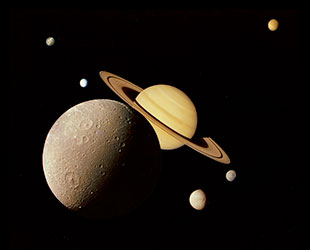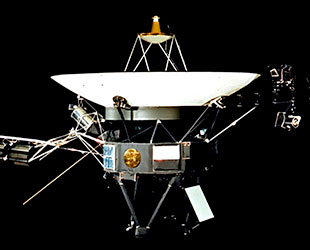August 20, 2002 — A quarter-century after NASA's two Voyager spacecraft departed Earth to visit outer planets, the historic mission is flying a race against time.
During the first 12 years after launch in 1977, the twin Voyagers chalked up a wealth of discoveries about four planets and 48 moons, including fast winds on Neptune, kinks in Saturn's rings and volcanoes on Jupiter's moon Io. As scientists and engineers mark the mission's silver anniversary, they hope at least one Voyager will pass beyond the boundary of the Sun's influence before their nuclear power supplies wane too low to tell us what's out there.
Voyager 1 is now the most distant human-made object, about 85 times as far from the Sun as Earth is. Voyager 2 is now about 68 times the Sun-Earth distance.
"After 25 years, the spacecraft are still going strong," said Dr. Edward Stone, Voyager project scientist since 1972 and former director of NASA's Jet Propulsion Laboratory (JPL), Pasadena, California. "Back in 1977, we had no way to know they would last so long. We were initially just on a four-year journey to Jupiter and Saturn."
The JPL Voyager team still receives information almost daily from the durable spacecraft traveling beyond all the planets. The Voyagers are examining the far reaches of the solar wind, a gusty flow of particles hurled outward by the Sun. The eventual goal is to become the first vehicle to taste interstellar space.

A montage of Saturn and its principal moons created from photos taken in November 1980 by the Voyager 1 spacecraft. (NASA) |
Voyager 1, which launched on September 5, 1977, flew past Jupiter and Saturn, then angled northward out of the plane of the planets' orbits. After Voyager 2 launched on August 20, 1977, and completed its tour of Jupiter and Saturn, NASA extended the spacecraft's adventure with flybys of Uranus in 1986 and Neptune in 1989.
"A radio signal traveling at the speed of light takes nearly 12 hours to travel between Voyager 1 and Earth. That raises operational concerns. If something went wrong onboard, at least a full day would lapse before a signal revealing the problem could reach Earth and commands to fix it could be returned. It could be too late," said JPL project manager Ed Massey.
As such, the team tries to anticipate any emergencies and program the computers with advance instructions on how to react to them, he said.
Both craft are studying the vast bubble the Sun inflates around itself by outward pressure of the solar wind. The bubble has a boundary, called the heliopause, where this outward pressure is counterbalanced by inward pressure of the interstellar wind. The wind outside that boundary is a flow of atoms and particles blasted from explosions of dying stars.
The location of the heliopause varies with the level of solar activity during the Sun's 22-year sunspot cycle and with changes in the interstellar wind, Stone said. Some scientists suggest that, on a much longer time scale, the interstellar wind may occasionally press the boundary far enough inward to sway Earth's climate.

NASA's twin Voyager 1 and 2 spacecraft, the longest continuously operating probes in deep space. (NASA) |
Voyager 1 is rushing toward the heliopause at about one million miles a day. Whether it gets there before about 2020, while it still has adequate electrical power, depends on how far away the heliopause is. Recent estimates are that, depending on that distance, it would take Voyager 1 between seven and 21 years to reach the heliopause.
Voyager 1 has already discovered that the outbound solar wind around it is slowing from effects of inbound particles leaking through the boundary. A much better prediction of the boundary's location will come when Voyager reaches the termination shock, where the solar wind begins piling up against the heliopause. That may come within the next three years, Stone estimates.
Whatever the future holds, Voyager 1 and 2 have already earned a prominent place in the history of exploration.
Among their big surprises: Jupiter's moon Io has active volcanoes. Jupiter's atmosphere has dozens of storms. Saturn's rings have kinks and spoke-like features. The atmosphere of Saturn's moon Titan extends far above the surface. Miranda, a small moon of Uranus, has a jumble of old and new surfacing. Neptune has the fastest winds of any planet. Neptune's moon Triton has active geysers.
Long after they fall silent, Voyager 1 and 2 will continue speeding away from our solar system with an "interstellar outreach program" of recorded photographs and sounds from Earth, Massey said.
